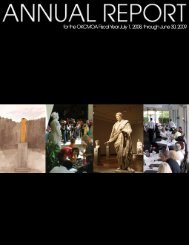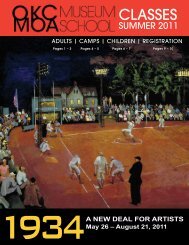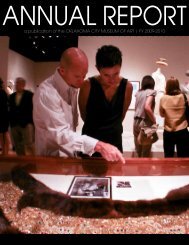Roman Art from the Louvre Educators' Resource Guide
Roman Art from the Louvre Educators' Resource Guide
Roman Art from the Louvre Educators' Resource Guide
Create successful ePaper yourself
Turn your PDF publications into a flip-book with our unique Google optimized e-Paper software.
26<br />
Discussion Starters<br />
1. Describe this relief. What types of<br />
people are shown? Can you guess what is<br />
about to take place? What does it tell you<br />
about religion in Rome?<br />
2. How does <strong>the</strong> artist use space, light,<br />
line, and shape to make this procession<br />
seem real? How does <strong>the</strong> artist convey a<br />
sense of movement in <strong>the</strong> procession?<br />
Has <strong>the</strong> artist created a sense of depth?<br />
Do <strong>the</strong> figures physically stand out <strong>from</strong><br />
<strong>the</strong> rest of <strong>the</strong> stone or are <strong>the</strong>y flat?<br />
3. Do <strong>the</strong> participants wear <strong>the</strong> same<br />
clo<strong>the</strong>s? Are <strong>the</strong>y all <strong>the</strong> same height?<br />
How can you distinguish <strong>the</strong> different roles<br />
of <strong>the</strong> participants?<br />
4. How is <strong>the</strong> emperor distinguished <strong>from</strong><br />
<strong>the</strong> rest of <strong>the</strong> figures in <strong>the</strong> panel? What<br />
message does this panel convey about<br />
<strong>Roman</strong> politics?<br />
5. Why do you think <strong>the</strong> artist wanted to<br />
record this ritual? What does <strong>the</strong> word ritual<br />
mean to you? Can you name a ritual that is<br />
performed at home or in school? How do<br />
you think rituals are learned and passed on?<br />
Activity: Capturing a Moment<br />
in Clay<br />
Materials: slabs of modeling clay<br />
measuring 8 by 11 inches, pencils, white<br />
paper; popsicle sticks, plastic knives,<br />
toothpicks, and o<strong>the</strong>r carving tools (if<br />
available and as age appropriate)<br />
4. Fragment of a Relief of a Double Suovetaurilia Sacrifice<br />
1st or 2nd quarter of 1st century A.D.<br />
Discovered in Rome at <strong>the</strong> end of <strong>the</strong> 15th century<br />
Gray veined marble<br />
70M x 90H in.<br />
Musée du <strong>Louvre</strong>; revolutionary seizure in 1798, exchanged in 1816,<br />
formerly in <strong>the</strong> Grimani collection (MA 1096–inv. mr 852)<br />
This relief shows a sacrificial procession. On <strong>the</strong> right, a priest wearing a<br />
veil performs <strong>the</strong> opening rites of <strong>the</strong> sacrifice, burning incense on an altar<br />
that holds various fruits. Following him are victimarii (assistants responsible<br />
for carrying out sacrifices) and a camillus (<strong>the</strong> individual who assists in<br />
<strong>the</strong> performing of rituals) holding an incense box. As testimony to <strong>the</strong> public<br />
nature of this religious procession, two lictors or imperial bodyguards—<br />
responsible for restraining onlookers in a crowd—stand facing one ano<strong>the</strong>r<br />
holding rods as symbols of authority. The laurel-leaf crowns worn by all<br />
<strong>the</strong> figures indicate that <strong>the</strong> scene is a state sacrifice in which <strong>the</strong> emperor<br />
himself probably participated as <strong>the</strong> priest. In addition to those involved in<br />
a sacrifice, <strong>the</strong> emperor was generally pictured wearing such a wreath.<br />
The type of sacrificial offering illustrated in this relief is known as a Suovetaurilia,<br />
named for <strong>the</strong> animals involved in <strong>the</strong> ceremony: a pig (sus), ram (ovis),<br />
and bull (taurus). This kind of religious offering was traditionally dedicated<br />
to Mars, <strong>the</strong> <strong>Roman</strong> god of war, and was often made to conclude a census or<br />
military campaign. The relief may commemorate <strong>the</strong> census organized by <strong>the</strong><br />
first <strong>Roman</strong> emperor, Augustus, and his successor, Tiberius, in 14 B.C.<br />
Procedure:<br />
1. Ask students to look at this relief and<br />
o<strong>the</strong>r examples of reliefs in <strong>the</strong> <strong>Roman</strong> <strong>Art</strong><br />
<strong>from</strong> <strong>the</strong> <strong>Louvre</strong> catalogue—such as<br />
Historical Relief, Sacrificial Scene (cat.<br />
no. 38), Historical Relief: Sacrifice of Two<br />
Bulls (cat. no. 39), and Fragment with an<br />
Inscription of Petronius Melior (cat. no.<br />
42).<br />
2. Have students choose an event or<br />
ceremony to portray in a relief.<br />
3. Ask students to draw a sketch of <strong>the</strong>ir<br />
scene.<br />
4. Have students carve <strong>the</strong>ir designs into<br />
<strong>the</strong> clay slabs. To start, <strong>the</strong>y should draw<br />
<strong>the</strong>ir image into <strong>the</strong> clay with a pencil.<br />
Then, to remove additional clay and make<br />
<strong>the</strong> figures stand out more <strong>from</strong> <strong>the</strong><br />
background, <strong>the</strong>y can scrape or chisel with<br />
a popsicle stick or plastic knife. Encour-
















